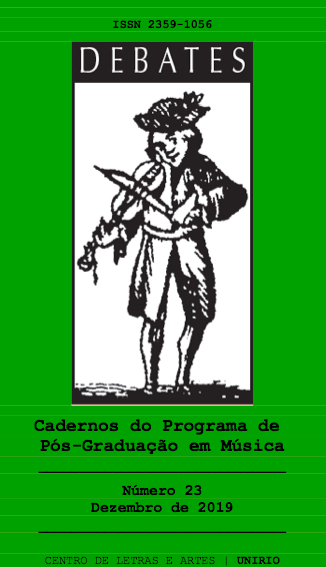Walking alongside me: listening, moving, performing and mapping the everyday
Palavras-chave:
soundwalk, authorship, storytelling, cartographyResumo
This article firstly introduces a mosaic of historical, theoretical and artistic inspirationsfor an on-going practice-based research focused on exploring the act of moving and listening through everyday space as an affective endeavor: the possible emergence of sensations, feelings or memories that modify our bond with a place. This poetic attitude permeates my thinking in regards to these elements: the mediation of my bodily and authorial presence; the design of a performance path through everyday space; the exploration of mobile audio technology as a presentational apparatus. These elements are described in performance works that explore: the ability of the listening subject to write their own story (walkwithmeand intoaforeignland); the usage of audio-visual documentation strategies in order to feed the creation of a live cartographic performance (come across).
Downloads
Referências
BEHRENDT, Frauke. The sound of locative media. Convergence: The International Journal of Research into New Media Technologies, v. 18, n. 3, p. 283–295, 2012.
CACCURI, Vivian. Caminhada Silenciosa: entre a pegação e o que está aqui. POIÉSIS, v. 16, n. 25, p. 81, 2015.
CARDIFF, Janet. Her Long Black Hair, 2004. Available at: <https://www.cardiffmiller.com/artworks/walks/longhair.html>. Accessed: 2 maio 2019.
CARLSON, Marla. Looking, Listening, and Remembering: Ways to Walk New York after 9/11. Theatre Journal, v. 58, n. 3, p. 395–416, 2006.
CARERI, Francesco. Walkscapes: walking as an aesthetic practice. 6th print run. Barcelona: Gili, 2009. (Land & scape series, 1).
CERTEAU, Michel de. The practice of everyday life. 1: ... 2. print. Berkeley, Calif.: Univ. of California Press, 2013.
CHAVES, Rui Miguel Paiva. Performing sound in place : field recording, walking and mobile transmission. Ph.D., Queen’s University Belfast, 2013. Available at: <https://ethos.bl.uk/OrderDetails.do?uin=uk.bl.ethos.602470>. Accessed: 7 maio 2019.
---- The idea of being a tourist in your own city. Nendú: a possible archive of Brazilian sound art made between 2016-2018, 2016. Available at: <http://www.nendu.net/?p=1231&lang=en>. Accessed: 12 jun. 2019.
---- Caminhada Silenciosa. Nendú: a possible archive of Brazilian sound art, 2017. Available at: <http://www.nendu.net/?p=1820&lang=pt>. Accessed: 12 jun. 2019.
COYNE, Richard. Designing information technology in the postmodern age: from method to metaphor. Cambridge, Mass: MIT Press, 1995.
COVERLEY, Merlin. Psychogeography. Harpenden: Pocket Essentials, 2010.
CRUST, Lee; KEEGAN, Richard; PIGGOTT, David; et al. Walking the Walk: A Phenomenological Study of Long Distance Walking. Journal of Applied Sport Psychology, v. 23, n. 3, p. 243–262, 2011.
KWON, Miwon. One place after another: site-specific art and locational identity. 1. paperback ed. Cambridge, Mass.: MIT Press, 2004.
KNABB, Ken (Org.). Situationist International anthology. Rev. and expanded ed. Berkeley, CA: Bureau of Public Secrets, 2006.
LABELLE, Brandon. Acoustic territories: sound culture and everyday life. New York: Continuum, 2010.
LAMBERT, Leandra. Cut-up Tragedy (music), no date. Available at: <http://leandralambert.net/cut-up-tragedy/>. Accessed: 12 jun. 2019.
----- Occe Anna Tlant X Cities, no date. Available at: <https://soundcloud.com/cut-up-tragedy/occe-anna-tlant-x-cities>. Accessed: 12 jun. 2019.
LONG, Richard. A Line Made by Walking’, Richard Long. Tate, 1967. Available at: <https://www.tate.org.uk/art/artworks/long-a-line-made-by-walking-p07149>. Accessed: 2 maio 2019.
NAKAHODO, Lilian. Mapa Sonoro CWB | Oficinas, 2016. Available at: <http://www.mapasonoro.com.br/?page_id=235>. Accessed: 12 jun. 2019.
NEUHAUS, Max. Walks. Wayback Machine, 1966. Available at: <http://web.archive.org/web/20090218020122/http://max-neuhaus.info/soundworks/vectors/walks/>. Accessed: 2 maio 2019.
PHELAN, Peggy. Mourning sex: performing public memories. London; New York: Routledge, 1997.
TURNER, Cathy. Palimpsest or Potential Space? Finding a Vocabulary for Site-Specific Performance. New Theatre Quarterly, v. 20, n. 04, p. 373–390, 2004.
SCHAFER, R. Murray. The soundscape : our sonic environment and the tuning of the world. Rochester Vt. ;[United States]: Destiny Books;Distributed to the book trade in the United States by American International Distribution Corp, 1994.
SOLNIT, Rebecca. Wanderlust: a history of walking. London: Verso, 2002.
WESTERKAMP, Hildegard. Soundwalking, 2001. Available at: <http://www.sfu.ca/~westerka/writings%20page/articles%20pages/soundwalking.html>. Accessed: 2 maio 2019.
WUNDERLICH, Filipa Matos. Walking and Rhythmicity: Sensing Urban Space. Journal of Urban Design, v. 13, n. 1, p. 125–139, 2008.


